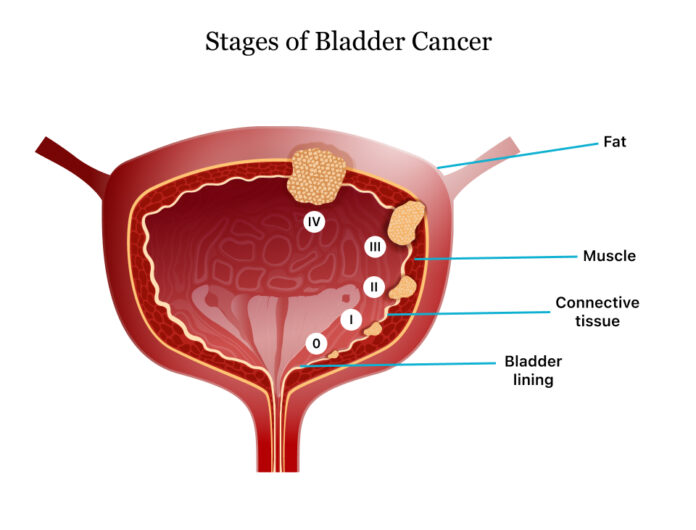Bladder cancer occurs when abnormal cells in the bladder lining grow uncontrollably, forming a tumor. It’s one of the most common cancers, especially in older adults, and affects men more frequently than women. Below is an overview of bladder cancer, covering types, symptoms, risk factors, diagnosis, treatment, and prevention.
1. Types of Bladder Cancer
There are several types, including:
- Transitional Cell Carcinoma (TCC): The most common type, starts in the urothelial cells lining the bladder.
- Squamous Cell Carcinoma: Less common, often linked to chronic irritation (e.g., infections or long-term catheter use).
- Adenocarcinoma: Very rare, starts in the mucus-secreting cells of the bladder.
2. Symptoms
Common signs of bladder cancer include:
- Hematuria (blood in urine): May be visible (gross) or microscopic (detected by testing).
- Frequent urination or a feeling of needing to urinate without being able to.
- Pain during urination.
- Lower back pain or pelvic pain in advanced stages.
3. Risk Factors
- Smoking: The biggest risk factor. Tobacco chemicals are absorbed by the bladder, damaging its lining.
- Chemical Exposure: Certain industrial chemicals, like those used in the production of rubber, leather, and dyes, increase the risk.
- Age: Bladder cancer is more common in individuals over 55.
- Gender: Men are more likely to develop it.
- Chronic Bladder Inflammation: Due to infections or prolonged use of catheters.
- Family History: A family history of bladder cancer or genetic mutations may raise the risk.
4. Diagnosis
- Urinalysis: Detects blood or abnormal cells in urine.
- Cystoscopy: A small camera inserted into the bladder to visualize tumors.
- Biopsy: Tissue samples taken during cystoscopy for microscopic examination.
- Imaging: CT scans, MRI, or ultrasound to see the extent of the tumor.
5. Stages
Bladder cancer is staged based on how deep the tumor invades into the bladder and if it has spread:
- Stage 0: Confined to the bladder’s inner lining.
- Stage I: Has spread to the connective tissue beneath the bladder lining.
- Stage II: Reached the muscle layer of the bladder.
- Stage III: Invaded nearby tissues/organs.
- Stage IV: Spread to distant parts of the body (metastasized).
6. Treatment Options
- Surgery: Most common treatment. Types include:
- TURBT (Transurethral Resection of Bladder Tumor): For early-stage cancer.
- Cystectomy: Removal of part or all of the bladder for advanced cases.
- Chemotherapy: Used before or after surgery to shrink tumors or kill remaining cancer cells.
- Immunotherapy: Helps the body’s immune system fight the cancer, often given directly into the bladder (BCG therapy).
- Radiation: Used when surgery isn’t possible or as an additional treatment.
- Targeted Therapy: Targets specific genetic changes in cancer cells.
7. Prognosis
The outlook depends on the stage and grade of the cancer at diagnosis:
- Early-stage bladder cancer has a high survival rate, especially if treated promptly.
- Advanced-stage cancer requires more aggressive treatment and may have a poorer prognosis.
8. Prevention
- Quit smoking: Reduces the risk significantly.
- Avoid chemical exposure: If you work with harmful chemicals, take safety precautions.
- Stay hydrated: Drinking plenty of water may help flush out toxins from the bladder.
- Routine screenings: If you’re at higher risk, regular check-ups can catch cancer early.
Bladder cancer is highly treatable when caught early, but it tends to recur, so ongoing surveillance is critical. If you have any more specific questions, feel free to ask!



